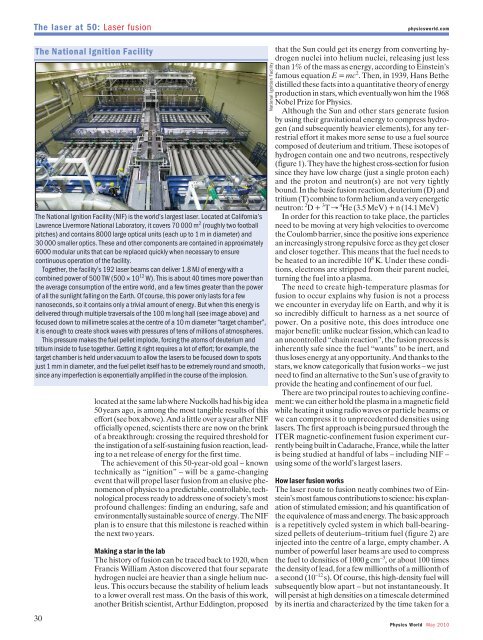special issue
special issue
special issue
You also want an ePaper? Increase the reach of your titles
YUMPU automatically turns print PDFs into web optimized ePapers that Google loves.
The laser at 50: Laser fusionphysicsworld.comThe National Ignition FacilityThe National Ignition Facility (NIF) is the world’s largest laser. Located at California’sLawrence Livermore National Laboratory, it covers 70 000 m 2 (roughly two footballpitches) and contains 8000 large optical units (each up to 1 m in diameter) and30 000 smaller optics. These and other components are contained in approximately6000 modular units that can be replaced quickly when necessary to ensurecontinuous operation of the facility.Together, the facility’s 192 laser beams can deliver 1.8 MJ of energy with acombined power of 500 TW (500 × 10 12 W). This is about 40 times more power thanthe average consumption of the entire world, and a few times greater than the powerof all the sunlight falling on the Earth. Of course, this power only lasts for a fewnanoseconds, so it contains only a trivial amount of energy. But when this energy isdelivered through multiple traversals of the 100 m long hall (see image above) andfocused down to millimetre scales at the centre of a 10 m diameter “target chamber”,it is enough to create shock waves with pressures of tens of millions of atmospheres.This pressure makes the fuel pellet implode, forcing the atoms of deuterium andtritium inside to fuse together. Getting it right requires a lot of effort; for example, thetarget chamber is held under vacuum to allow the lasers to be focused down to spotsjust 1 mm in diameter, and the fuel pellet itself has to be extremely round and smooth,since any imperfection is exponentially amplified in the course of the implosion.30located at the same lab where Nuckolls had his big idea50 years ago, is among the most tangible results of thiseffort (see box above). And a little over a year after NIFofficially opened, scientists there are now on the brinkof a breakthrough: crossing the required threshold forthe instigation of a self-sustaining fusion reaction, leadingto a net release of energy for the first time.The achievement of this 50-year-old goal – knowntechnically as “ignition” – will be a game-changingevent that will propel laser fusion from an elusive phenomenonof physics to a predictable, controllable, technologicalprocess ready to address one of society’s mostprofound challenges: finding an enduring, safe andenvironmentally sustainable source of energy. The NIFplan is to ensure that this milestone is reached withinthe next two years.Making a star in the labThe history of fusion can be traced back to 1920, whenFrancis William Aston discovered that four separatehydrogen nuclei are heavier than a single helium nuc -leus. This occurs because the stability of helium leadsto a lower overall rest mass. On the basis of this work,another British scientist, Arthur Eddington, proposedNational Ignition Facilitythat the Sun could get its energy from converting hy -drogen nuclei into helium nuclei, releasing just lessthan 1% of the mass as energy, according to Einstein’sfamous equation E = mc 2 . Then, in 1939, Hans Bethedistilled these facts into a quantitative theory of energyproduction in stars, which eventually won him the 1968Nobel Prize for Physics.Although the Sun and other stars generate fusionby using their gravitational energy to compress hydrogen(and subsequently heavier elements), for any terrestrialeffort it makes more sense to use a fuel sourcecomposed of deuterium and tritium. These isotopes ofhydrogen contain one and two neutrons, respectively(figure 1). They have the highest cross-section for fusionsince they have low charge (just a single proton each)and the proton and neutron(s) are not very tightlybound. In the basic fusion reaction, deuterium (D) andtritium (T) combine to form helium and a very energeticneutron: 2 D + 3 T → 4 He (3.5 MeV) + n (14.1 MeV)In order for this reaction to take place, the particlesneed to be moving at very high velocities to overcomethe Coulomb barrier, since the positive ions experiencean increasingly strong repulsive force as they get closerand closer together. This means that the fuel needs tobe heated to an incredible 10 8 K. Under these conditions,electrons are stripped from their parent nuclei,turning the fuel into a plasma.The need to create high-temperature plasmas forfusion to occur explains why fusion is not a processwe encounter in everyday life on Earth, and why it isso incredibly difficult to harness as a net source ofpower. On a positive note, this does introduce onemajor benefit: unlike nuclear fission, which can lead toan un controlled “chain reaction”, the fusion process isin herently safe since the fuel “wants” to be inert, andthus loses energy at any opportunity. And thanks to thestars, we know categorically that fusion works – we justneed to find an alternative to the Sun’s use of gravity toprovide the heating and confinement of our fuel.There are two principal routes to achieving confinement:we can either hold the plasma in a magnetic fieldwhile heating it using radio waves or particle beams; orwe can compress it to unprecedented densities usinglasers. The first approach is being pursued through theITER magnetic-confinement fusion experiment currentlybeing built in Cadarache, France, while the latteris being studied at handful of labs – including NIF –using some of the world’s largest lasers.How laser fusion worksThe laser route to fusion neatly combines two of Ein -stein’s most famous contributions to science: his explan -ation of stimulated emission; and his quantification ofthe equivalence of mass and energy. The basic ap proachis a repetitively cycled system in which ball-bearingsizedpellets of deuterium–tritium fuel (figure 2) areinjected into the centre of a large, empty chamber. Anumber of powerful laser beams are used to compressthe fuel to densities of 1000 g cm –3 , or about 100 timesthe density of lead, for a few millionths of a millionth ofa second (10 –12 s). Of course, this high-density fuel willsubsequently blow apart – but not instantaneously. Itwill persist at high densities on a timescale determinedby its inertia and characterized by the time taken for aPhysics World May 2010



